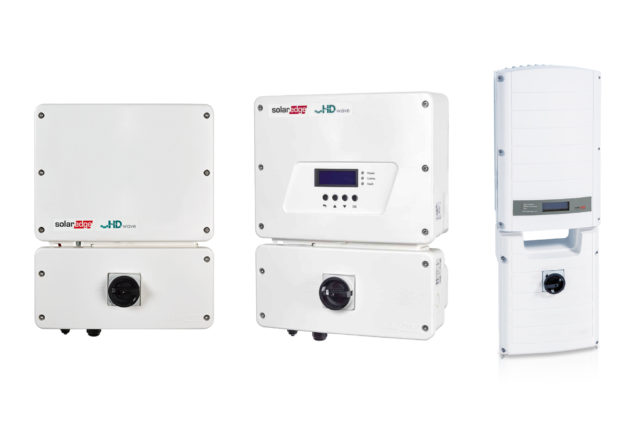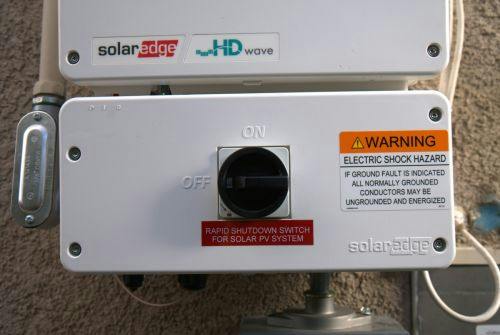The SolarEdge inverter lights indicate the system’s operational status. A green light signifies normal function, while a red or orange light suggests an issue.
SolarEdge inverters are a key component in solar panel systems, renowned for their efficiency and smart monitoring capabilities. These innovative devices convert the direct current (DC) electricity generated by solar panels into the alternating current (AC) electricity that powers homes and businesses.
Understanding the LED indicators on your SolarEdge inverter is crucial for maintaining the health of your solar energy system. With just a glance, the lights provide a first line of information regarding the performance and safety of your unit. Regularly checking these lights ensures you’re informed about your inverter’s status and can promptly address any potential concerns, keeping your solar system operating optimally.
Understanding Solaredge Inverter Lights
When it comes to optimizing your home’s energy efficiency, understanding the status and performance of your solar inverter is pivotal. Solaredge inverters, renowned for their advanced technology and efficiency, come equipped with indicator lights that serve as a communication gateway for homeowners. These lights can tell you at a glance whether your system is running smoothly or if it needs attention. Let’s demystify these signals and uncover the importance of these seemingly small, yet incredibly significant, features of your Solaredge inverter.
Basics Of Solaredge Inverters
The Solaredge inverter is a sophisticated piece of equipment that converts the direct current (DC) generated by your solar panels into alternating current (AC), which is what powers your home and gets fed back into the grid. This integral component of a solar energy system not only ensures the optimal performance of your panels but also includes a monitoring platform that provides valuable insights into system health and energy production.
Functions Of Indicator Lights
The indicator lights on your Solaredge inverter perform a crucial role in communicating the status of various operational aspects. Here is a breakdown of what these lights mean:
- Green Light: A steady green light indicates that the inverter is operating properly and is successfully converting solar energy into usable power.
- Red Light: If you see a red light, this is an alert that there may be a system error or malfunction that requires attention.
- Blue Light: The presence of a blue light typically means the inverter is connected to the internet and successfully relaying data to the Solaredge monitoring platform.
Flashing lights can represent different states of operation, such as updating firmware or other processes that are part of the inverter’s regular operation.
Importance In System Monitoring
Understanding what each indicator light signifies is more than about immediate reassurance. These lights play a vital role in system monitoring and overall maintenance. Regular observation of these lights can help homeowners promptly identify and address issues, maintain system efficiency, and ensure a longer lifespan for their solar inverter. Without these clear, instantly recognizable signals, diagnosing problems would be a cumbersome process, often requiring professional intervention.
By keeping an eye on the Solaredge inverter lights, homeowners can stay well-informed about their system’s health and performance, ensuring they get the most out of their solar investment. This hands-on approach to monitoring can also lead to significant savings on energy and maintenance costs over time.
Decoding The Light Indicators
Understanding the status and functionality of your Solaredge Inverter is crucial for the optimal performance of your solar power system. The inverter’s light indicators provide vital information at a glance. By decoding the light indicators on your Solaredge Inverter, you’ll be better equipped to recognize its operational status, potential issues, and whether it requires maintenance or a more in-depth diagnosis.
The meaning of different light colors
The Meaning Of Different Light Colors
The Solaredge Inverter uses various light colors to communicate with you. These colors are not just for aesthetics; they carry significant information about the inverter’s activities and condition. A quick scan of these colors can tell you plenty:
- Green: Your inverter operates smoothly, and the system is producing power efficiently.
- Red: Signals an issue that might need immediate attention and possibly component servicing.
- Blue: Indicates that the inverter is connected to Wi-Fi and communicating with the monitoring platform.
Flashing versus steady lights
Flashing Versus Steady Lights
The nature of the light—whether it’s flashing or steady—also conveys unique messages:
| Light Status | Condition |
|---|---|
| Steady Green | System is performing normally, without any issues. |
| Flashing Green | Power production is ramping up, usually observed during sunrise or when coming out of a fault state. |
| Steady Red | System has detected a persistent fault that may require the attention of a technician. |
| Flashing Red | A fault has been detected and the system is attempting to reconnect or remedy the issue. |
| Steady Blue | Stable Wi-Fi connection and successful communication with the monitoring platform. |
| Flashing Blue | The inverter is attempting to establish or re-establish a Wi-Fi connection. |
Troubleshooting common light patterns
Troubleshooting Common Light Patterns
Troubleshooting light patterns on your Solaredge Inverter isn’t as daunting as it seems. Here’s how to approach some common patterns you might encounter:
- Continuous Red: Check for inverter codes on the display. Refer to the user manual for the specific error code for potential solutions.
- Flashing Reds: Wait a few minutes; the inverter might be trying to resolve the issue internally. If the condition persists, document the interval and duration of flashes for technical support.
- Blue light issues: If the constant or flashing blue light is observed without green light indication, ensure the Wi-Fi connection is active. Check your router settings or consider restarting your inverter to refresh the connection.
For all light patterns, if issues continue, seeking assistance from a certified Solaredge technician is recommended as they are trained to handle complex diagnostics and repairs.
Optimizing Inverter Performance
For any solar energy system, the inverter is a critical component, acting as the heart of the operation by converting the direct current (DC) from your solar panels into the alternating current (AC) that powers your home. An efficient inverter means a smoothly running solar system, and a SolarEdge inverter is no exception. Maximizing the performance of your SolarEdge inverter not only ensures optimal energy production but can also lead to prolonged system life and reduced energy bills. Let’s dive into the best practices to keep your inverter operating at peak efficiency.
Regular Maintenance Routines
Like any sophisticated piece of technology, a SolarEdge inverter requires regular upkeep to maintain top performance. Here’s what you should focus on:
- Visual Inspections: Check for any physical damage or wear and tear. Ensure the inverter is clean and free from dust and debris, which can hinder performance.
- Cooling Vents: Confirm that the inverter’s cooling vents are unobstructed to prevent overheating.
- Connection Check: Secure all electrical connections, as loose wires can cause inefficiency or even safety hazards.
Performing these checks regularly helps mitigate potential issues that could impact your SolarEdge inverter’s performance.
Software Updates And Diagnostics
Equally important are the software aspects of inverter maintenance. Staying updated with the latest software is crucial:
- Update Firmware: SolarEdge regularly releases firmware updates to enhance inverter functionality and security. Ensure your system is up to date with the latest version.
- Diagnostic Reports: Utilize SolarEdge’s monitoring platform to run diagnostic reports. This could help identify potential issues before they escalate.
Maintaining the software side of your SolarEdge inverter contributes significantly to overall system health.
Interpreting Efficiency Through Lights
The SolarEdge inverter comes with a display that uses lights to convey important information about the system’s operational status. Decoding these lights can provide immediate insights into the inverter’s efficiency:
| Led Indicator | Status | Meaning |
|---|---|---|
| Green | Solid | Normal Operation: Inverter is performing optimally. |
| Red | Blinking | Fault: There may be an issue requiring attention. |
| Blue | Blinking | Bluetooth: Inverter is in Bluetooth pairing mode. |
By understanding these indicators, you can ensure your system is running efficiently and address any issues promptly for uninterrupted solar energy production.
When Solaredge Lights Signal Trouble
Understanding what the lights on your Solaredge inverter indicate can be crucial for maintaining your solar system’s health and efficiency. While the inverter is engineered to be robust and reliable, certain light patterns may raise a red flag, signaling that your system requires attention. Below, we delve into how to effectively identify and respond to troubling signals from your Solaredge inverter lights.
Identifying Warning Lights
The lights on your Solaredge inverter are like the dashboard indicators of your car — they communicate the status of your system. When something’s amiss, specific lights will flash or remain solid to alert you. To decode these signals, refer to your user manual, which will list the color and state of the LED indicative of potential issues like:
- System error: A red light that remains solid or blinks can indicate operational issues.
- Isolation fault: This issue may trigger a red light and requires immediate attention.
- AC or DC overvoltage: Specific light patterns could indicate voltage issues which could impair the inverter’s function.
Steps For Initial Troubleshooting
- Refer to the inverter’s user guide: Match LED patterns to the guide’s troubleshooting section.
- Perform a system reboot: Sometimes a simple restart can clear transient errors.
- Check for visible obstructions or damage to the inverter and surrounding wires.
- Review the error log in the system’s monitoring platform for additional insights.
Should these steps not resolve the issue, maintain a record of the warning light sequence and any additional error codes that may have appeared on the inverter’s screen. This information is essential for further diagnosis.
When To Contact A Professional
If initial troubleshooting doesn’t rectify the problem, it’s time to consult a professional. A certified technician possesses the tools and expertise to diagnose and remedy inverter issues safely. Here are scenarios when professional intervention is recommended:
| Light Indication | Recommended Action |
|---|---|
| Consistent red light or specific error code | Contact support immediately |
| No lights or unresponsive system | Check for power supply issues; call a technician if unresolved |
| Recurring error after restart | Seek professional help to prevent further damage |
Reach out to your installation company or Solaredge support for service or warranty inquiries. When safety is a concern or the situation appears complex, never hesitate to bring a skilled technician on board. Proper handling at the first sign of trouble not only ensures maximum system uptime but also prolongs the lifespan of your solar investment.
Enhancing System Longevity
Ensuring your SolarEdge inverter operates efficiently for years to come is not just about leveraging its advanced technological features; it’s also about adopting practical maintenance strategies to enhance system longevity. A well-maintained inverter can not only provide consistent energy production but also safeguard your investment in solar technology. Let’s delve into the best practices for inverter care, the impact of environmental factors, and how to use the inverter lights as a guide for preventative measures.
Best Practices For Inverter Care
Taking proper care of your SolarEdge inverter is paramount to maintaining its efficiency and long-term functionality. Here’s what you can do:
- Regular Inspection: Conduct routine visual checks for any signs of damage or wear.
- Cleanliness: Keep the inverter free from dust and debris, which can cause overheating.
- Ventilation: Ensure there is adequate space around the inverter to prevent overheating.
- Updates: Stay up-to-date with the latest firmware updates provided by SolarEdge.
- Professional Maintenance: Have a certified technician perform an annual check-up to maintain optimal performance.
Impact Of Environmental Factors
Environmental conditions can greatly affect the performance and lifespan of your inverter:
| Factor | Impact | Mitigation |
|---|---|---|
| Temperature | High temperatures can lead to overheating and reduce efficiency. | Install in a location away from direct sunlight and ensure proper cooling. |
| Moisture | Humidity and water ingress can cause corrosion and electrical issues. | Ensure adequate waterproofing and install in a low-humidity area. |
| Dirt/Dust | Build-up can impede cooling mechanisms and obstruct operation. | Regular cleaning and placement in a less dusty environment. |
Preventative Measures Guided By Lights
The LED indicator lights on your SolarEdge inverter are not just status indicators; they’re a gateway to understanding the health of your system. Here’s how they can help:
- Green Light: Everything is functioning correctly—routine checks suffice.
- Red or Orange Light: This indicates an issue that requires immediate attention.
- No Light: Potential power issues; verify breakers and connections before calling for support.
By closely monitoring these lights and responding to the signs they provide, you can take proactive steps to maintain your inverter’s health, such as:
- Consulting the SolarEdge troubleshooting guide for specific error codes.
- Contacting a professional for support if an unresolved issue persists.
- Implementing the best practices for environmental factor mitigation as dictated by the indicators.

Credit: suncommon.com
Frequently Asked Questions
What Do Solaredge Inverter Lights Indicate?
Solaredge Inverter lights display the system’s operational status. A steady green light means normal functioning, while a blinking green indicates energy production. Red or orange lights can signal different alarms or faults, requiring attention or troubleshooting.
How To Interpret Solaredge Inverter Error Codes?
Error codes are displayed on the inverter’s screen or flashing lights. Each code corresponds to a specific issue, like grid faults or communication problems. Consult the Solaredge manual or website for detailed explanations and recommended actions.
Can Solaredge Inverters Work During A Power Outage?
Generally, Solaredge Inverters shut down during power outages for safety, unless paired with a backup battery system. Some models may support a feature called backup power, which provides limited electricity during an outage.
How To Reset A Solaredge Inverter?
To reset a Solaredge Inverter, turn off the AC and DC disconnects, wait several minutes, then turn them back on. This can resolve minor glitches and restore normal operations. For more complex issues, contacting support is advisable.
Conclusion
Understanding the signals from your SolarEdge inverter lights can vastly improve system management. Quick identification ensures prompt action, safeguarding efficiency. Embrace the simplicity of LED indicators to keep your solar investment on track for optimal performance. Stay illuminated, stay informed.

